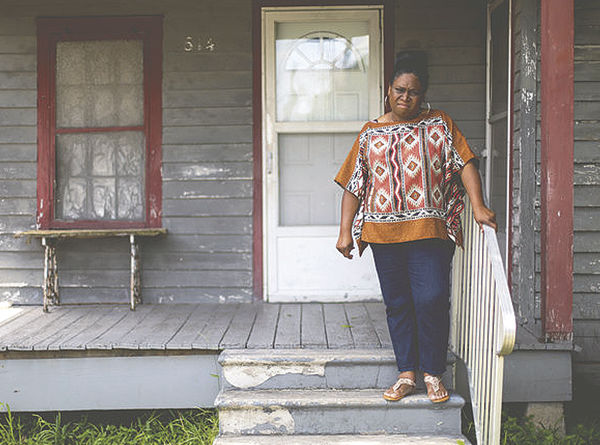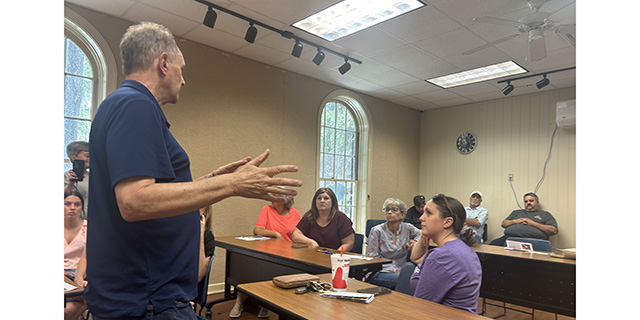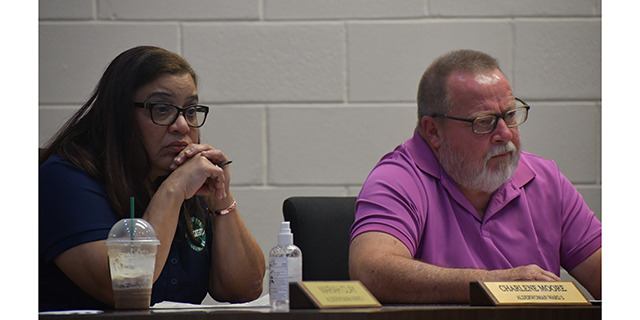STILL IN MOURNING
Published 12:00 am Monday, July 23, 2018

- Althea Hill Augustine stands on the front porch of her late mother’s home on Hopkins Street. Augustine has lost a daughter and her mother to gun violence in New Iberia.
“I guess you could say I lost my mind,” Deanna Landry said, sitting dejectedly on her couch. “It’s only the last few years that it’s been coming back to me — sort of.”
On a Friday night in December 2004, Landry’s son, Nelson Landry Jr., left home in a brand new car and never returned.
“I knew something was wrong the next day when he wasn’t home because he hadn’t called,” she said. “He always calls his mom — at work, on breaks, at lunch.”
Monday rolled around, and Landry hadn’t slept all weekend. When Nelson didn’t show up to work, she said, she really knew something was wrong. So did her other son.
“His brother, Jeremy, was driving into work that Monday morning, and he said he just couldn’t go in,” Landry recalled. “He turned around and came over and said, ‘Mom, we’ve got to file a report.’”
The two called the police and filed a missing persons report. A member of the Iberia Parish Sheriff’s Department, who had recently taken over jurisdiction of the city of New Iberia after the city council had dissolved its police department earlier that year, came over to ask for more details.
Two days later, Landry said, the IPSO called to say they’d found her son’s car in a wooded area on the outskirts of town, near Olivier.
“They told us if we wanted we could come take the car.” I said, “‘What do you mean we can come take the car? That’s part of a missing persons report. Don’t you need it for evidence?’ They said they weren’t aware of a missing persons report. They said, okay, they’ll take it to forensics.”
Over the next several months, Landry and teams of friends and relatives scoured the city and the parish, searching any wooded patch of land they could find, looking for her son or clues to what happened to him.
“We searched everywhere — all over Olivier, wooded areas in New Iberia, anywhere with country grounds,” she said. “We had 50 people looking, out to St. Martinville even.”
In February, authorities found Nelson’s body on private land, his head submerged in a crawfish pond near where the car had been found.
Almost 14 years since he went missing, the murder remains unsolved.
“We had rallies, we had marches. The news offered a reward. Nothing came of it. I would go to the Sheriff’s department every day and ask to speak with the Sheriff (Sid Hebert). He was never available. Nothing came of it,” Landry said.
“After that, I ain’t had nothing to do with them,” she said of the sheriff’s office. “You never have closure. The people who did it are still walking around. After my son died, my life’s never been the same.”
Problem with reporting
According to FBI data, in the decade prior to the dissolution of the New Iberia Police Department in 2004, city police cleared slightly more than 85 percent of all homicides; in the decade since (from 2005 to 2016, the most recent year for which there is available data), the IPSO has cleared less than 20 percent.
According to that same data set, the IPSO has not cleared a single homicide since 2008, and there were zero homicides in 2015.
But neither of these latter statistics are accurate.
FBI homicide data is based on information voluntarily submitted by the more than 18,000 local law enforcement agencies across the country, from city and county/parish to university and state police departments through the Uniform Crime Report system; that data is then published by the FBI in its annual “Crime in the United States” report.
The discrepancy between those data points and what we know is true in Iberia Parish is the result of shockingly bad crime reporting practices from the IPSO, researchers familiar with the program say.
The IPSO seemingly has failed to report complete or accurate homicide data since at least 2008. What is clear is that the rate at which parish law enforcement officials have cleared homicides has dropped drastically, and is well below the national average.
According to IPSO Public Information Officer Capt. Wendell Raborn, the department cleared three of six homicide cases it worked in 2016, and has no date for previous years.
“These are not stats that we keep,” Raborn said. “I am relying on the investigators to get me the information.”
Meanwhile, the Center for Disease Control and Prevention also keeps track of homicide deaths each year, but not of cases cleared. Whereas the data for the FBI’s UCR program begins with police reports, the CDC’s Fatal Injury Reports program’s data begins with state death records; and whereas FBI data comes from the voluntary reporting of law enforcement agencies, the CDC’s FIR data comes from the mandatory reporting of each state’s vital registrars, which account for every death in their jurisdiction.
When you compare the CDC’s reported number of homicides in Iberia Parish between 1999 and 2016 — the most readily available data set — with the data the IPSO supplied the FBI during that same period, the disparity is clear: 97 reported homicides from the former and only 27 from the latter.
“That is God awful. That’s like the worst reporting I’ve ever heard,” said Thomas Hargrove, a man who has seen a lot of crime data reporting. “That is ferociously bad.”
Hargrove, a former investigative reporter and White House correspondent, has built a homicide data-mining tool in his retirement. With a team of law enforcement officials and criminologists, he runs the non-profit Murder Accountability Project, which houses the nation’s largest catalog of homicide and homicide clearance data.
Where he has seen poor reporting in the FBI’s data gaps he has pursued local and state agencies for public information, filing Freedom of Information Act requests and, when necessary, suing for public records. He has accrued case-level homicide data on, as of this writing, 752,313 murders, including 27,000 additional homicides in Alabama, Illinois, Florida and Washington, D.C. that were never reported to the FBI. He said there is a direct connection to the murder rate and good data reporting.
“First of all, you haven’t a clue whether murders are being solved in your (parish). This is literally a matter of life and death,” he said. “Illinois is a great case in point.”
In 1994, the state stopped reporting homicide clearance rates; in the intervening 23 years, Illinois has come to lead the nation in both homicides and unsolved homicides. The missing statistics were recovered when Hargrove successfully sued the state for access to them.
“People were cheated. They were not given information on how bad things were, and so they were unable to tell their elected representatives, ‘This is unacceptable!’” he said. “People are more likely to be murdered in places that do a poor job of accounting for murder.”
Split opinions
On Saturday, Dec. 4, 2015, the Delahoussaye family met at the Seafood Connection in New Iberia to celebrate the birthday of Terry Delahoussaye Sr., who had just turned 62.
“We sat and we laughed and we clowned, we did it all,” his sister Dorothy recalled fondly.
After dinner, Terry left to visit with a cousin who had recently lost a son. He was to cook food for a memorial service, and went to go plan for it.
Terry, after a divorce, was living with Dorothy at the time. She got up the next morning and noticed Terry had not come home, but thought little of it. She left to go to work, then saw in her rearview mirror her daughter’s car pulling up behind her.
“She said, ‘Momma, I need you to come with me.’ And my immediate words, quote-unquote, were, ‘What’s happened to Terry?’”
Dorothy told her client she had to leave, and went with her daughter to the corner of Field and Corinne Streets.
“As I drove up, I’m looking at all the flashing lights and the police and the ambulance and I just knew it wasn’t good,” she said. “And as I walked up I met with my youngest sister, Charmaine — she’s employed with the sheriff’s department — and, I mean, all of her coworkers and all had discovered what had happened.
“And all of her coworkers were trying to make it easier on us,” she said. “And we walked up and discovered that my brother had been shot in the head and was found dead in his truck.”
It has been three years since Terry Delahoussaye was murdered in an apparent robbery. He had left the Seafood Connection with gold jewelry and a significant amount of money in his wallet and none was found on him when he was discovered. The shots had come from the back seat, suggesting to family members that it was someone he’d known and let into the car. To this day, the murder remains unsolved.
In those three years, the family has continued to believe in a steadfast mantra.
“The only thing we’ve vowed is to never let his case become a cold case,” Dorothy said. “We will never let this become a cold case.”
But, unlike many relatives of victims of recent gun violence in New Iberia, the Delahoussayes, who live east of the Bayou Teche, are split in their attitudes toward the IPSO. The Delahoussayes have a proud history in local policing. Their father, Gilbert Delahoussaye Sr., was the first black police officer in New Iberia, and the first to achieve the rank of sergeant; Dorothy was once married to Mack Antoine, the city’s first black lieutenant and first black captain.
“I have nothing against the department,” she said, a sentiment her sister Charmaine — who works under IPSO Sheriff Louis Ackal as a bailiff — echoes.
“I have no problem with Louis Ackal,” she said. “People want to blame them, but where I get the negative vibes from are people that are up there having to deal with him. When they do wrong, they don’t like the consequences for what happens to them. But what do you expect? Nobody wants to talk to them. How can they solve crimes if no one is willing to talk?”
Terry’s younger brother, Ricky, is less sanguine about the investigation from the beginning, expressing opinions commonly heard west of the bayou where most of the violence has been concentrated.
“Ackal did not do his job! They were too busy looking for drugs on him, while he was lying there fighting for his life,” he said of responding officers, a criticism Landry had also made of the IPSO.
“If you call and say, ‘There’s a drug deal going on,’ they’ll come right away. But if you call and say, ‘Someone’s dying at the end of the street,’ they’ll be here in 40 minutes, an hour. Ackal ain’t doing nothing,” Landry said.
Ricky, voicing a widely held view west of the Bayou Teche, put it more bluntly.
“It feels like they’re just saying, ‘let the n—–s kill the n—–s,” he said. “‘It’s a black-on-black crime, so who cares.’ When it happens across the bayou, it’s different. When a white guy gets shot they treat it differently. Yeah I’m pissed off, and I’m going to stay pissed. I used to think my brother was in the wrong place at the wrong time. Now, my opinion is different.”
A regular complaint
This reaction is not without precedent. Low homicide clearance rates often hit poor and black communities hardest.
“African American murders are much less likely to be cleared than any other kind of murder,” said Hargrove. “Those are also more likely to be drug and gang related” — statistically harder cases to clear — “but that doesn’t begin to explain the depth of the racial divide. We are not providing sufficient resources to African American murders.”
It’s a longstanding complaint.
Crime reporter Jill Leovy found in 2015 that “the strength of Ghetto feelings about hostile police conduct may even be exceeded by the conviction that ghetto neighborhoods are not given adequate police protection.” Survey participants in Harlem and Watts, she found, “mention inadequate protection more often than brutality and harassment” for police resentment.
This echoes through the 20th century. The 1968 Kerner Commission found that “If a black man kills a black man, the law is generally enforced at its minimum.” Two decades prior, in 1944, Swedish sociologist Gunnar Myrdal found that “everywhere in Southern Negro communities I have met the complaint from law-abiding Negroes that they are left practically without police protection … As long as Negroes are concerned and no whites are disturbed, great leniency will be shown in most cases.”
“Forty years after the civil rights movement,” Leovy concluded, “impunity for the murder of black men (remains) America’s great, though mostly invisible, race problem.”
“The sheriff’s department is not doing their job,” said Kevin Bowser, 29, who is still mourning the loss of his little brother, Deondrick Bowser. Deondrick was murdered on Jan. 21 of this year.
“He had just gotten his life together. He had a job working for disaster relief, and was taking care of his kid. He stepped outside for not even five minutes and was gunned down with an AK-47 on Deer Street,” Bowser said. “The sheriff didn’t do nothing until my dad called the DA. The police response was poor. We kept calling and calling and calling, and we heard nothing from them.”
On a recent night, he said, after shots rang out near his grandparents’ home, it took officers more than a half hour to respond.
“They said, ‘We’ve only got three officers on patrol right now — one in New Iberia, one in Coteau and one in Jeanerette.’ How are you going to respond with that?”
“The only time we’ve felt the sheriff’s presence was when they had IMPACT, and that was just to beat us up,” said Cynthia Lewis, referring to the special unit directly implicated in the department’s civil rights case. “That was just to beat on us for any old reason, and after they took that away, it seems like the sheriff just went away.”
Lewis watched her own son Dante Lewis die on Hopkins Street in March of this year, not even knowing it was him. Her daughter had shown her a livestream of a shooting on Facebook Live.
“She said, ‘Mom, somebody got shot again,’” Lewis explained.
“I said, ‘Lord, somebody’s child is dead.’ I didn’t even know it was mine,” she said, choking back tears.
“They don’t even care what the family is going through, they’re just quick to run to Facebook,” she said, finally sobbing. “All I could see was the image of my child, lying on the ground. I said, ‘Lord, whose child is this?’”
Soon, Dante’s girlfriend was calling, telling her people were saying Dante had gotten shot. Lewis and her daughter gathered themselves into a car and sped to Hopkins Street, where police told them to report to the coroner’s office at Iberia Medical Center.
When they got to the coroner’s office, Lewis said, she saw Dante’s father, with his head slung low. That’s when she burst into tears. Dante was 26 years old.
“It’s so hard, because I still don’t know anything,” she said. “The police, they never called me, they never talked to me. I really don’t know anything. The streets know more than you, and they’re talking. Everybody seems to know but me and the police.”
People’s reluctance to speak with the police and to serve as witnesses is often cited as the primary impediment to solving homicides. But with low levels of trust and the perceived lack of protection, it can become a chicken-and-egg conversation.
“The people don’t want to talk to the sheriff’s department because the sheriff’s department has proven not be a friend of the community,” said Robbie Bethel-Carrier, a longtime community activist in the West End and the program manager of a free summer enrichment program for youth there. “When the head of your department says it’s okay to call the residents monkeys, it’s okay to turn a dog loose on somebody, it’s okay to shove a stick down their throat to sexually violate them — who would talk to them?” she said, referring the testimonies of several IPSO deputies during Ackal’s 2006 federal civil rights violations trial.
“Ackal, if he showed more that he cared, it’d go a long way,” said Althea Augustine Hill, who lost both a young daughter and an elderly mother to stray bullets in the West End. “There are some police that care. But these youngsters know that Ackal doesn’t care, so they’ll continue with this.”
A violence monopoly
The research and expertise tends to bear out Hill’s point.
“I can tell you that we have demonstrated that the failure to solve murders promotes more murders,” said Hargrove. “When police start to devolve so that they’re just not solving murders, well, they’re more likely than not to get a higher number of murders. When you leave killers on the street, A: they’re available to kill again, and B: they become a walking, living testament to the fact that there will be no repercussions.”
The father of modern criminal law and justice, Enlightenment thinker Cesare Beccaria, outlined this common sense philosophy in his 1764 treatise “On Crime and Punishment,” which forms the basis of modern criminal justice. His famous theory of deterrence simply stated that the punishment of offenders deters others from committing such offenses. Two decades later the philosopher Jeremy Bentham theorized that the certainty and swiftness of apprehension and punishment decreases crime more than any other measure, and modern criminology bares this out. Recent studies from the U.S. Department of Justice have shown that the certainty and celerity of arrest and punishment seem to be the most important element in preventing crime, beyond the severity of sentence or any other situational factors.
Like reporting rates, the rate at which police clear homicides — a term with varying definitions, but which broadly refers to fingering and apprehending a suspect, though not necessarily convicting or punishing them — varies widely from city to city and from state to state. The worst agencies clear homicides less than 20 percent of the time, while others clear them more than 90 and even 100 percent of the time.
Nationally, the average rate of homicide clearance has been steadily declining across the country since peaking above 90 percent in the early 1960s. In 2016, the most recent year for which data is available, the national average hit an all-time low of 59 percent.
“We are less likely now to solve a murder than we’ve ever been,” said Hargrove. Besides poor data, he said, it is mostly because of a lack of resources.
“We have less cops, less investigators, less forensic technicians, less laboratories — we have less of everything,” he said. “And these shortages of resources overwhelmingly hurt African American communities.”
The New Iberia experiment was duplicated across the country after the 2008 financial crash. In 2010, 78 percent of U.S. police agencies cut budgets, which included reducing officer positions, cutting overtime hours, eliminating pay raises and/or reducing training.
“By cutting the possibility of overtime pay,” one scholar wrote in 2016, “police agencies are also reducing the willingness of officers to put in extra time on tough cases.”
A 1999 paper determined four variables said to improve clearance rates by about 96 percent: having at least three detectives assigned to a case, having detectives arrive on the scene within 30 minutes, having the detectives describe the scene in detailed notes and having detectives follow up on all witness information.
“These conditions cannot possibly be met if the police department’s resources are stretched thin, which may be why so many more cases go cold in the busy 21st century,” they concluded.
It will be a while before Hargrove’s MAP project begins looking into homicide records reporting from police agencies in the state of Louisiana, he said. Until then, Iberia Parish residents will not have clear homicide clearance date for the last decade, but with a new city police department comes new hope.
“As to whether this is tolerated is up to community leaders, including the press, where these failures are occurring. Meanwhile,” he said, residents will have to rely on “stories by local journalists” to “persuade our local police to accurately report murders to state and federal authorities.”
A New Hope
The FBI data reporting system is entirely voluntary, so what the IPSO is doing — or, rather, not doing — is in no way illegal. But, as Hargrove makes clear, it keeps the public in the dark about community safety, lowers public accountability and hinders criminology research.
And while it is clear that the IPSO reporting behavior is abnormally bad, reporting habits vary dramatically across the country, with plenty of offenders.
“A lack of reporting homicide data is not widespread but, as you can see from your police, it does happen,” Hargrove said.
Lack of accountability had been one of the major critiques that Mayor Freddie DeCourt had of the arrangement between the city and IPSO. In town hall after town hall this past fall, as he campaigned to pass the half-cent sales tax that will eventually fund the new department, he lamented not just a string of unsolved homicides but also the lack of oversight he had over parish law enforcement.
“In every other city, the mayor is accountable for the police, the council members are responsible for what happens in their districts. Let me do my job!” he said at one town hall last September. With the new department on the streets, his wish will be granted.
The other big gripe he had, of course, was the breakdown in relations between the IPSO and the residents it was contracted to protect. The buzzword surrounding the new department has been “community policing,” hinting at a plan to restore that relationship. Todd D’Albor, the new chief of police, mentioned as much at his city council confirmation this past November.
“You’ve got to engage the community and listen to those concerns,” he said. “One thing that I don’t believe in is sending police out there just to show force.”
Almost universally, the victims of relatives spoken to for this story voiced optimism and enthusiasm for the incoming department.
“I think it might make a whole lot of difference out here,” Landry said. “If they hadn’t taken the police out of the city there wouldn’t have been all of this killing.”
They’ll need to make their way around the neighborhood on foot, she said, out of their cars, “getting to know people.”
“Todd D’Albor worked narcotics in New Iberia before, he got it done,” said Karen Anne Jones, a former addict who now helps parents in grief. “He had informants, he got tips. He’ll help this city to a whole new level. There will be more patrolling, everything.”
Bethel-Carrier said she believes the new department has already started building trust in the community.
“I think that the hiring practices so far for the city police, with the mayor and his staff — I think we’re seeing some willingness to make sure that all i’s are dotted and all t’s are crossed. And we’ve seen that with the people he’s hiring,” she said, listing off the credentials of the new department’s top brass. “For the first time in this city, we have a number of African Americans at the top of the chain of police command.”
She said several officers have participated in community programs in the West End, including a recent “Save our Youth” summit at the end of the school year.
“They talked about respecting citizens, and telling them they’re not there to harass but to protect them,” she said.
“I believe there’s no way a community can survive without law enforcement, because you have to have enforcement to have law and order. Otherwise, you have every person fending for themselves, and it’s the wild wild west,” she said.
For some time, it has felt more and more like that. But at long last, residents seem hopeful that a sense of peace and safety may soon settle again in New Iberia.





